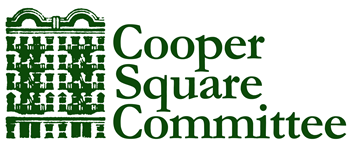- In 1959, the Cooper Square Committee (CSC) formed to oppose the City of New York’s Slum Clearance plan. Throughout the 1960’s, the Cooper Square Committee built coalitions, held demonstrations and spoke out at public hearings against the Robert Moses urban renewal plan. Equally important, the Cooper Square Committee held many public meetings with its members to create an alternative plan.
- In the late 1960’s, the Cooper Square Committee’s members created a community based plan, known as “The Alternate Plan,” which established basic principles that are still relevant to the neighborhood:
» Displacement must be minimized
» Development must be carried out in stages
» Site tenants must have first priority for the housing that is developed
- On February 13, 1970, the Cooper Square Committee forced a vote by the Board of Estimate on the CSC’s Alternate Plan for the urban renewal area, and it was adopted as the official plan of the City of New York for the urban renewal area.
- By defeating the City, CSC’s founding members preserved over 300 buildings, and prevented the displacement of several thousand people, including families, senior citizens, artists and art organizations.
- In the 1970s Cooper Square Committee was instrumental in developing community leadership on the Lower East Side. CSC organized the Bowery Residents Committee, the Good Food Co-op, Third Avenue Artists, and also helped start several tenant associations. Members of CSC formed a new tenant rights organization called Good Old Lower East Side (GOLES), which is an ally today in preserving affordable housing.
- In 1985, the Cooper Square Committee sponsored development of a Section 8 building for low-income households at 10 Stanton Street, known as the Thelma Burdick building.
- The Cooper Square Committee supported development of senior citizen housing on 5th Street and the Bowery. It was developed in 1985 by a private builder and is now managed by the Jewish Association of Services for the Aged (JASA). CSC works closely with JASA to ensure that it be a racially-integrated building.
- In 1986, the Cooper Square Committee created a Revised Plan for the Cooper Square Urban Renewal Area. It emphasized renovation of city-owned tenements and loft buildings, preservation of affordable housing and new construction of mixed income housing.
- In 1988, Cooper Square Committee convinced HPD to approve the development of the 22 unit Cube Building on 16-18 2nd Avenue for formerly homeless families.
- In 1990, the Cooper Square Committee and the Dinkins Administration signed a Memorandum of Understanding in accordance with many of the principles spelled out in our 1986 Revised Plan. The MOU paved the way for renovation and preservation of over 300 low income housing units.
- In 1991, Cooper Square Committee founded the Cooper Square Mutual Housing Association which now manages 356 apartments in 22 formerly city-owned buildings. CSC sponsored the renovation of the 22 buildings, which cost over $20 million, took place from 1991 through 2006.
- Cooper Square Committee was a key player in negotiations with the Cooper Square Task Force created by the City in 1997 to develop a consensus for a development plan for the Cooper Square Urban Renewal Sites around Houston Street and the Bowery. The new development has resulted in over 750 new mixed apartments, over 100,000 sq. ft. of retail, and a new 40,000 sq. ft. community center with a gymnasium and swimming pool.
- In 2000, the Cooper Square Committee began organizing the cultural groups on East 4th Street to develop a plan for disposition of 4 city-owned cultural buildings and 2 vacant buildings on East 4th Street, as well as 2 vacant lots on E. 3rd Street. Planning efforts culminated in the sale of the city-owned properties to the cultural groups in 2005.
- The Cooper Square Committee partnered with Community Access, Inc. to develop a new 53 unit apartment building at 29 E. 2nd St. with supportive services. The building received a TCO in December, 2007, and was rented up by mid-2008.
- The development of the Cooper Square Urban Renewal Area was largely completed in 2008. 846 of the 1,377 new and renovated apartments are low income units (61% of the total). The sites also contain over 100,000 sq. ft. of cultural space on East 4th Street (currently under renovation) and 40,000 sq. ft. of recreational space.
- The Cooper Square Committee is administering $250,000 in NYS Main Street Funds from the NYS Housing Trust Fund for cultural buildings on East 4th Street. To date, CSC has provided matching funds for a new elevator at 59-61 E. 4th St. (2007), façade improvements to 5 buildings on the block (2008-09), and streetscape improvements.
- The Cooper Square Committee has partnered with Fourth Arts Block to sponsor a Streetscape Master Plan for the East 4th Street Cultural District. The block, which contains over a dozen Off Off Broadway theaters, draws over 200,000 arts patrons to the block each year. Phase 1 of the Master Plan was implemented in 2008, with the installation of FAB banners. Phase 2 in underway.

3 thoughts on “Our Historical Accomplishments”
Comments are closed.